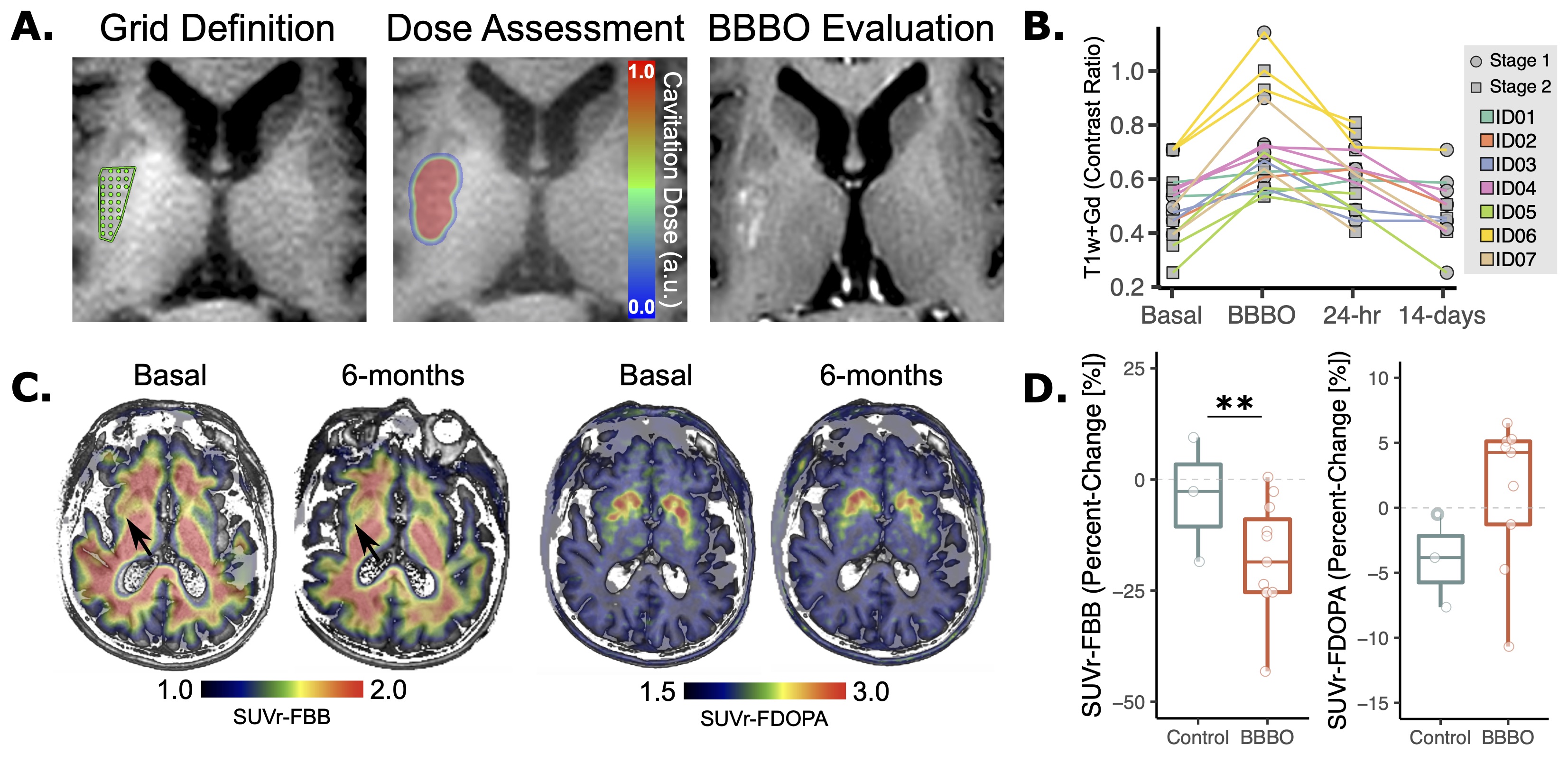Objective: To test safety and feasibility of repeated low-intensity focused ultrasound (FUS) blood brain barrier opening (BBB) in the striatum of Parkinson’s disease (PD) patients.
Background: Parkinson´s disease (PD) exhibits a high prevalence of dementia. Striatal pathology is involved in motor and cognitive manifestations in PD, and specifically β-amyloid deposition in this area correlates with risk for conversion to PD dementia (PDD)1. Low-intensity focused ultrasound (FUS) in combination with microbubbles has been applied for transient blood-brain barrier (BBB) opening of cortical areas in common neurodegenerative disorders 2–5. However, the safety of this procedure in subcortical areas such as the striatum, which has the greatest potential for pharmacological therapies in PD, has not been proven.
Method: Seven PD patients were treated for BBB opening in the posterior putamen as part of a phase I clinical trial (NCT03608553). This was performed in two sessions separated by 2-4 weeks, where the second session included bilateral putamina opening in three patients. Primary outcomes were safety and feasibility of focal striatal BBB opening, the latter evaluated by Gadolinium-enhanced MRI. Additional exploratory outcomes included changes in motor and cognitive functions, and PET imaging of 18F-fluorodopa and 18F-florbetaben.
Results: The procedure was feasible, well-tolerated, and with no serious adverse events. BBB opening was confirmed in all the procedures. Three patients received bilateral opening in the second session. BBB closing occurred shortly after treatment and hemorrhagic and ischemic lesions were ruled out. No neurologically relevant change in motor and cognitive functions was recognized upon follow up. A significant reduction of 18F-florbetaben uptake in the targeted region (median [interquartile range] = -18.6% [-25.3% – -9.0%], P = 0.0019) was found, with no change in 18F-fluorodopa PET. Noteworthy, the degree of BBB opening assessed by contrast enhancement on T1-weighted MRI with Gadolinium showed a significant correlation with the reduction in amyloid burden (R2 = 0.61, P=0.005).
Conclusion: FUS-mediated BBB opening shows potential to become an effective tool to facilitate safe and repeated delivery of putative neurorestorative molecules to specific brain regions in Parkinson´s disease and other neurodegenerative disorders.
References: 1 Biundo R, Weis L, Fiorenzato E, et al. The contribution of beta-amyloid to dementia in Lewy body diseases: a 1-year follow-up study. Brain Commun 2021; 3.
2 Lipsman N, Meng Y, Bethune AJ, et al. Blood–brain barrier opening in Alzheimer’s disease using MR-guided focused ultrasound. Nat Commun 2018; 9: 1–8.
3 Abrahao A, Meng Y, Llinas M, et al. First-in-human trial of blood–brain barrier opening in amyotrophic lateral sclerosis using MR-guided focused ultrasound. Nat Commun 2019; 10: 1–9.
4 Gasca-salas C, Fernández-rodríguez B, Pineda-pardo JA, et al. Blood-brain barrier opening with focused ultrasound in Parkinson’s disease dementia. Nat Commun 2021; : 1–7.
5 Rezai AR, Ranjan M, D’Haese PF, et al. Noninvasive hippocampal blood−brain barrier opening in Alzheimer’s disease with focused ultrasound. Proc Natl Acad Sci U S A 2020; 117: 9180–2.
To cite this abstract in AMA style:
C. Gasca-Salas, J. Pineda-Pardo, B. Fernández-Rodríguez, I. Obeso, F. Hernández-Fernández, C. Trompeta, R. Martínez-Fernández, M. Matarazzo, D. Mata-Marín, P. Guida, G. Foffani, G. Toltsis, I. Rachmilevitch, J. Blesa, R. Rodríguez-Rojas, M. Del-Alamo, J. Obeso. Striatal Blood brain barrier opening in Parkinson´s disease [abstract]. Mov Disord. 2022; 37 (suppl 2). https://www.mdsabstracts.org/abstract/striatal-blood-brain-barrier-opening-in-parkinsons-disease/. Accessed December 23, 2025.« Back to 2022 International Congress
MDS Abstracts - https://www.mdsabstracts.org/abstract/striatal-blood-brain-barrier-opening-in-parkinsons-disease/

